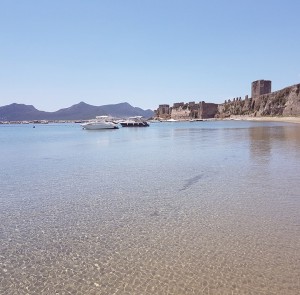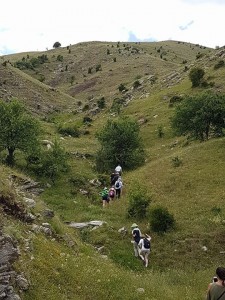Bright sunlight, long windy roads that stretch far into the distance, and more mountains than you can count. The bus ride through mainland Greece feels like a vacation while staring out at a green screen…the views cannot be possible. Today will be the last day of touring on the bus and enjoying the landscape because tonight we reach our last location which is Athens. However first we will visit two famous and exciting sites: Epidaurus and Corinth – two popular sites in the ancient world. I’m very excited.
Epidaurus was a small city state in ancient Greece on the Argolid Peninsula in the Saronic Gulf. The Asklepieion at Epidaurus was the most celebrated healing centre of the Greek world, the place where ill people went in the hope of being cured. It was so cool to see such a place that held such significance for so many people. The site also features the most well preserved theatre in all of Greece! Visitors are allowed to fully interact with the site and are encouraged to try out the theatre’s excellent acoustics. The group took turns performing at the theatre however many of us were distracted because we found two very playful, very cute kittens. How could we not be distracted??
On the way to Corinth the group stopped for lunch at a small cafe beside the Isthmus Canal. The word ‘isthmus’ comes from the ancient greek word meaning “neck”. It is a narrow canal that connects the Peloponnese with the rest of mainland Greece. Simply because of that the canal has always been very important. The Isthmus Canal is a wonder within itself. It is an extremely high, 6,343 metres long, canal that also seems too narrow to fit the massive ships that pass through it. I met a man named Kostos who worked at the cafe and he told me that the canal was used in the tv show The Amazing Race, and the participants had to bungee jump off of it. Would you bungee jump off of it?
We got to Corinth around 2 pm and I almost immediately went into the museum. The museum currently is featuring two graves recently found near the site. The skeletons are of two adult males both who died around the age of 35. One of the skeletons had osteoarthritis due to repeating an action with his right arm over and over his whole life. I personally love the work that science can do with ancient bones these days. I love knowing what people ate and how they lived. I think that it adds a certain concrete knowledge to the life of the ancients.
The actual site of Corinth is very well preserved, I was happy to see. It features a stoa and a famous road named the Lechaion Road which was the first road that connected Corinth to its port. The road still exists and is amazing. The feeling of walking down the road which once would have been bustling with people and shops is a wondrous feeling. Today was an amazing day.
If anyone reading this wants to travel to mainland Greece I highly recommend visiting Epidaurus and Corinth. The two sites are well preserved similar to how they would have been in the ancient world. It was a magical and fun day.











